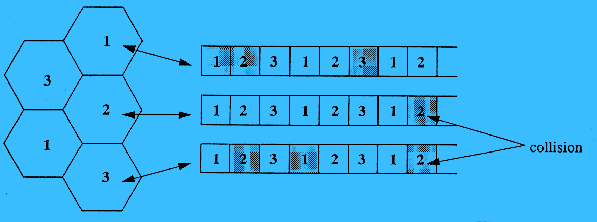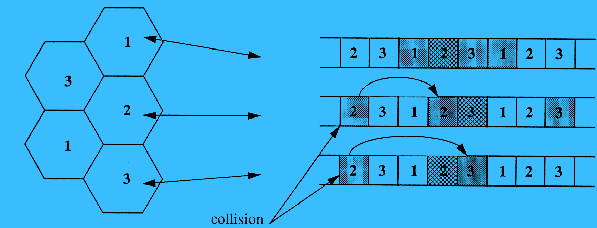
Spatial Collision Resolution
Spatial Collision Resolution (SCR) is a method that can be used in
cellular packet data networks
to allow multiple portable
terminals to access a
communications infrastructure. It combines
frequency reuse
(in space or area) with multiple access. The goal is to develop new radio
access techniques that are better suitable to bursty multi-media traffic.
Background
In high-capacity spectrum-efficient
packet-switched networks, adjacent base stations
preferably compete for non-disjoint (i.e.,
interfering) spectrum resources, rather than using a fixed frequency reuse pattern.
Spectrum efficiency
is optimal if the full system bandwidth can be used in all cells. However, continuing
interference between transmissions from adjacent base station may severely affect the
performance of such networks. This suggests that efficient, coordinated resolution of
collisions between packet retransmissions in adjacent cells is necessary to guarantee
efficient performance of wireless data and
multi-media
networks. SCR mitigates the effect
of continued collisions in packet-switched radio
data networks with dense frequency reuse:
Basic Idea
All base stations share the same transmit
channel, which has frames of three time slots. The areas covered by each base station are
assigned a sequence number {1, 2 or 3} according to
a map-coloring scheme which
ensures that adjacent areas always have a different
number. In normal operation, a base
station can transmit in any time slot regardless of its number. If base stations in
adjacent areas happen to transmit simultaneously,
most signals may nonetheless
'capture'
their intended receiver. With some probability
however,
interference erases some messages
involved in this `collision'. In the latter case, the base station will retransmit the lost
message in the slot of the next frame with the corresponding
number. During this
retransmission, all adjacent base stations are silenced to
prevent another collision.
This coordination can be performed by protocols using the fixed backbone
infrastructure, connecting all base stations.
Example

Cellular packet data network with C = 1 under normal Contiguous Frequency
Assignment (CFA) operation, i.e., if no destructive collision occurs. Any base station can
transmit in any time slot, accepting the risk of excessive
interference from cochannel
transmissions in nearby cells.

Spatial Collision Resolution (SCR) in cellular
packet data network. Base
stations only transmit in the time slots with the
corresponding sequence number. During
retransmissions, all adjacent base stations must refrain
from transmitting.





